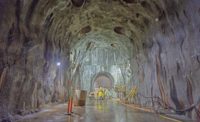The not-so-common oscillation method of drilling holes for enormous underground pillars of concrete proved to be an excellent solution in a construction area that called for careful mitigation.
Drilled shafts are nothing new in the bridge construction industry; along with pile foundations, drilled shafts are one of the two most common foundations used to secure large structures like bridges. In Utah, however, the not-so-common oscillation method of drilling holes for enormous underground pillars of concrete proved to be an excellent solution in a construction area that called for careful mitigation.
The Utah Department of Transportation Region 2 EXPRESSLink project is building three bridges along I-15 between Salt Lake County and Davis County in Utah. Drilled shafts are being used at the bent foundations of each of the bridges. The bridges, located at Beck Street, U.S Highway 89 (U.S. 89) and 1100 North in Salt Lake City, are in areas replete with conflicts including silty soil, a high water table, pressurized utility lines and close proximity to rail road tracks and residential and commercial neighbors. The oscillation method of drilling neatly addresses each of these conditions.Additionally, the drilling method can save time by allowing the project to progress without encountering delay due to underground obstructions.
How it’s done
The drilling operation on the EXPRESSLink project was conducted by Malcolm Drilling of Seattle, Washington. Malcolm uses an oscillator to push casing into the ground, and then excavates soil from within the casing.
The UDOT Region 2 job at Beck Street required a three meter casing oscillator to drill a 2.8 meter diameter shaft. Malcolm used reusable casing segments bolted together to reach depths of 115 to 120 feet.
A Kobelco 2500CK 250 ton crane was used to lift and place the casings. A Liebherr dual cycle crane was used to suspend a hammer-grab clamming shell with a jaw that opens and closes. As the oscillator displaced soil, the clamming shell removed soil that was then loaded directly onto trucks for quick and clean removal from the construction site.
After the casing was fully excavated, a steel rebar cage was placed in the casing as reinforcement for the concrete.
The Kobelco service crane also placed the cages. The casings were removed as the concrete was poured. It took several days per shaft, with drilling and pouring happening on different shafts simultaneously at the each site.
Oscillation means mitigation
Learning this method of drilling was expensive and time consuming but after 10 years of experience, Malcolm officials believe the time and expense was well worth the investment. Few contractors use this method, according to Lance Rasband, project manager at Malcolm drilling. “Pile driving or conventional drilling would have been risky at this site considering ground conditions,” says Rasband.
Soil conditions at the U.S. 89, Beck St., and 1100 North sites were problematic due to loose silts and sandy soils that are often typical in areas with a high water table. The oscillation method advantage over other drilled shaft methods was three fold: First, having a fully cased shaft controlled for soil conditions by preventing the shaft from caving in. Second, the oscillation method prevents soil from sinking around the excavation area. Third, pile driving or uncased shafts in silty soil conditions can limit the...



Post a comment to this article
Report Abusive Comment